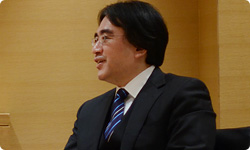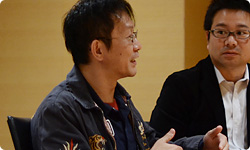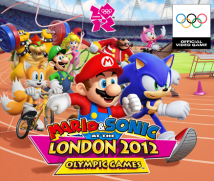3. Synchronised Swimming in Your Living Room
It seems there was a bit of a struggle against the characters’ traits with regard to swimming. Did you struggle with any of the other events?
Mario & Sonic at the Olympic Games had the high jump. Track and field athletes usually lead with their back, but when we tried to have Bowser do that, his shell was too hard.
He couldn’t bend his back. (laughs)
So you couldn’t tell what he was doing. It looked like he was just flipping over in the air. (laughs)
Bowser would be at quite a disadvantage. The spikes on his shell would hit the bar!
Yeah. So we decided to have Bowser do a belly-roll. There’s a cycling event called Team Pursuit this time. In addition to Bowser, a lot of the characters have short legs. They had trouble pedalling, so we made special bicycles.
Oh, you had to custom-design bikes for them! (laughs)
Yeah. Then they could pedal with their short legs.
Horses were that way, too. A new event this time is Equestrian-Show Jumping.
The characters’ leg length wouldn’t matter with horses.
Of course, it’s easy to imagine Mario or Sonic riding a horse, but when massive characters like Bowser or Donkey Kong mount, it just looks hard on the horse!
(laughs)
So we made the horses’ legs and necks thicker for the horses that Bowser and Donkey ride. They look a little tougher and not as pitiable. They perform the same, though.
You made the game so that while the characters have various visual characteristics, no single one comes with a particular advantage over the other.
That’s right. Every character has an even chance.
So Sonic isn’t faster at the 100m Sprint and Mario isn’t better at the high jump.
Right.
Did you ever feel like making them different?
Yes, but if we did that, two players can’t play the same character at the same time in this game so whoever chose Sonic first for the 100m Sprint would win. We made it so that wouldn’t happen.
I see. Mario & Sonic at the London 2012 Olympic Games is the second game for the Olympic Games for summer, following Mario & Sonic at the Olympic Games. Was there a different pressure this time once you got started?
Yes, there was. If we just did the same thing, people would say we were in a rut.
In order to combat that, what did you think about as you began making the game?

We can’t just change the rules of the regular events at the Olympic Games, so while including events that we didn’t in the first game, we thought about introducing difference through what we call Dream Events - games which aren’t real Olympic events.
What are the Dream Events like?
Mario & Sonic has two broad categories of events. The main one is the regular Olympic events. You tend to try to set records in that one, so it’s fairly serious gameplay. The Dream Events, on the other hand, have strong party-game elements for simultaneous play by four people.
We can emphasise the characteristics of Mario and Sonic in the Dream Events, so we could put in gameplay more like a regular video game.
How many events are there in total this time?
Altogether, there are 31. The Dream Events account for ten of those.
How about in the first game?
There were 20 events in eight sports for the Olympic events. For the London game it was 21 events in 13 sports.
The number of events increased, giving it more variety.
Yes. There were four Dream Events in the first game, so that has more than doubled, too.
What themes did you work on when adding new events?
There were a lot, but we tried not to make everything focused on one action, like swinging for example.
It’s easy to end up with nothing but games that involve swinging the Wii Remote controller really fast.
Yeah.
The first game had a lot of running games. You could play instinctively by alternately swinging the Wii Remote and Nunchuk just the way you swing your arms when you actually run, but after it went on sale, some people said it was tiring.

It’s tiring to keep swinging your arms for so long.
Yeah. So this time, while we left in events with physical controls, you don’t just keep swinging. Instead, we devised ways to introduce more variation into game control, by holding the remote sideways and pressing buttons, for example. Of course, when it comes to events like Badminton , in which you swing a racket, it’s easier to swing the Wii Remote, but this time we divided it up, deciding up front how many events would involve swinging, limiting ourselves to those, and not using swinging for other events.
You divided it up by looking at the overall balance and thereby introduced variety into the controls.
Yes. We wanted as little similarity as possible in the controls between the various games.
Watanabe-san, did that bear fruit?
Yes, I believe it really did. For example, a new Olympic event this time is Synchronised Swimming . At first, we were making it so that a marker would appear on the screen for each person. You would watch that and swing the remote at the right timing. Game-wise, it was pretty strict.
While you were playing, all you would do is watch the marker.
Right. Then we thought it would be fun to synchronise on this side of the television screen.
You wanted to make it so that, instead of the synchronised action taking place inside the television, the players would do it themselves in their own living rooms.
Yeah! We wanted to make it so the players could all enjoy doing the same performance.
We actually got that idea from Watanabe-san’s group and remade it. With four players, everyone raises their hands together. That looked really fun.
That scene itself was fun.
I had the opportunity to make a presentation to those involved with this project overseas. When I demonstrated synchronised swimming, it went over really well. And not just for the people playing. The people standing around watching clapped and were like, “Whoa!” (laughs) So I was glad that we got advice from Watanabe-san.
Oh… I’m glad to hear that!
